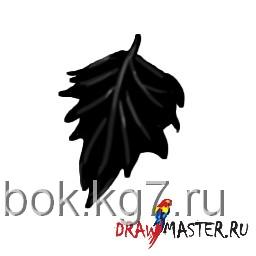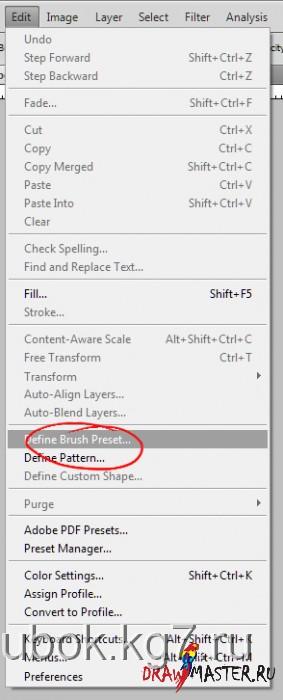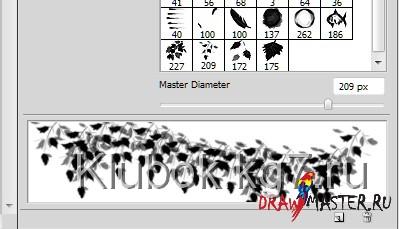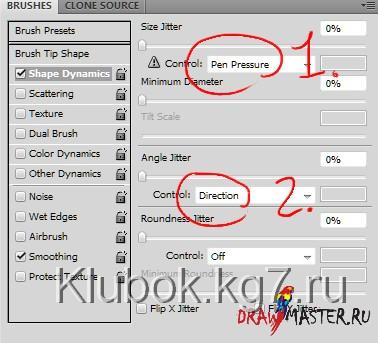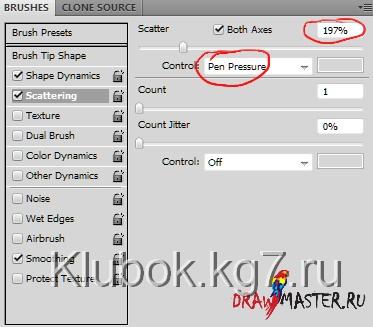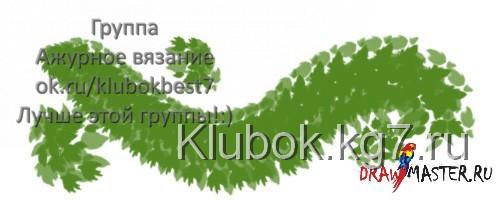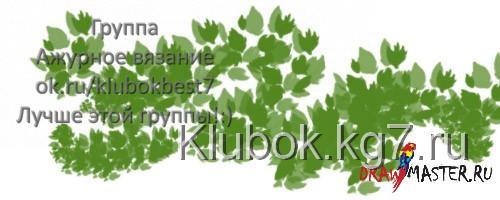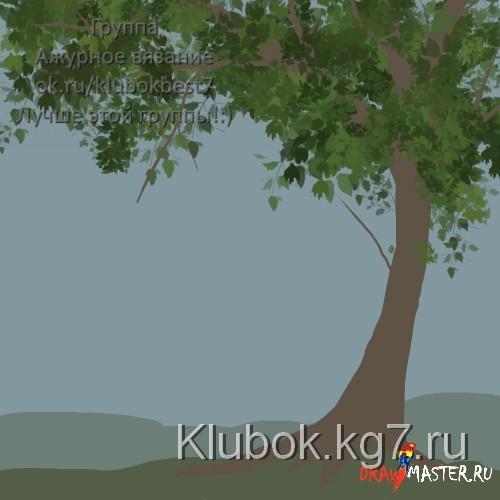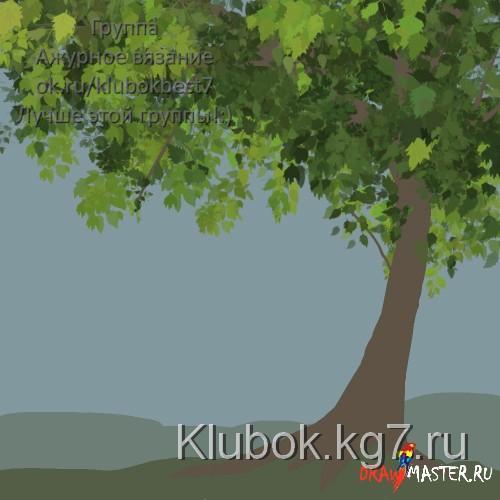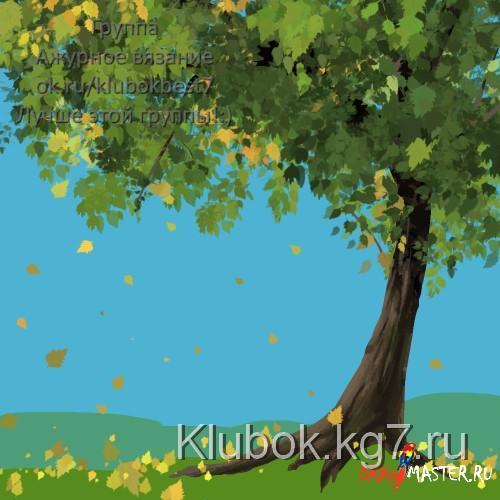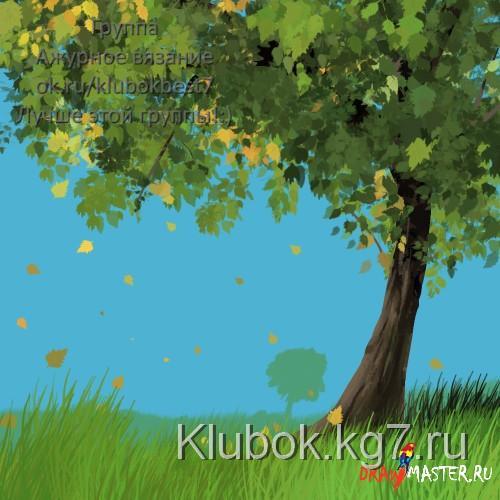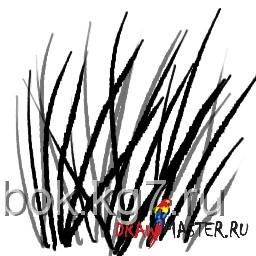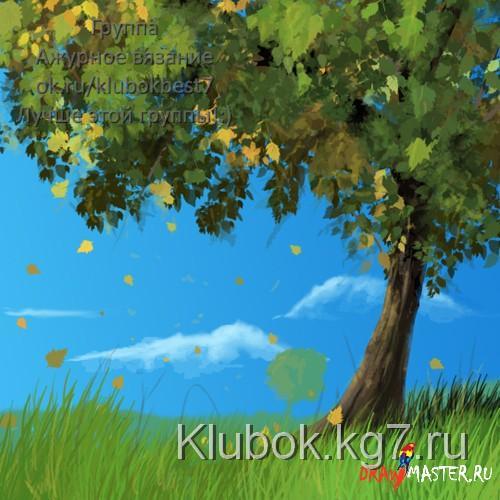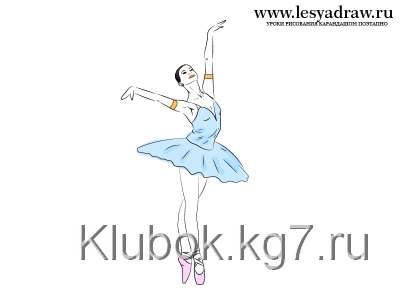Рисуем красивые деревья за несколько минут
Добавлено: 04.04.2015 в 15:02 Просмотров: 56816
Рисуем красивые деревья за несколько минутKlubokhttp://klubok.work/14/83/5754/Klubokhttps://klubok.kg7.ru/css/image/top-logo.png
Данная статья, прежде всего, будет
полезна начинающим художникам, но, надеюсь, может пригодиться и более опытным
людям. Обладание планшетом желательно, урок идет в расчете на него.
Прежде всего начнем с того, что не
надо делать. Если у Вас много свободного времени, то можете провести ближайшие
несколько недель вырисовывая каждый листочек. Этого я делать категорически не
советую, есть более легкий и доступный путь.
Итак, Вы полны решимости в "выращивании" собственного
дерева, а то и целого леса? Тогда начнем.
Перво-наперво, сверните будущий "холст" для шедевра и
создайте новый документ до 1024*1024 pix. В нем мы будем создавать свои
собственные кисти, после чего разберемся с несколькими параметрами, которые
существенно облегчат нам жизнь.
Проблема всех новичков - это
боязнь разобраться как работают кисти в Photoshop, на что влияют многие
параметры и для чего они нужны. Это не наш метод, кисти надо любить, холить и
лелеять. Тогда кисти ответят Вам тем же.
Возвращаемся к новому документу, который мы создали и
начинаем делать заготовки будущих листьев. Для подготовки этого урока я создал 4
разных кисти:
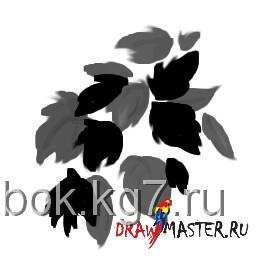
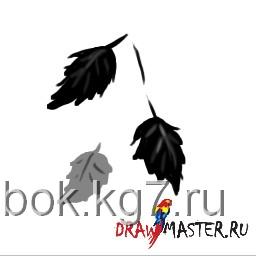
1) самая густая листва
2) Листьев
поменьше
3) 3
листика
4)
одиночный лист
Первая и
основная кисть у нас пойдет на создание основного массива будущего дерева.
Вторая и третья - больше для корректировки формы и создания дополнительных
деталей. Четвертая - для добавления отдельных листьев на крону, чтобы она не
смотрелась однообразно.
В
интернете много описаний того, как создаются кисти. Основные моменты - размер
документа до 1024*1024 пикселей, рисовать надо на белом фоне черным цветом.
Черный цвет в кисти будет самым непрозрачным, белый наоборот - прозрачный. Все
оттенки серого будет иметь различную прозрачность в зависимости от близости к
черному или белому.
Итак, рисуем листья. Тут все зависит от Вашей фантазии и
предпочтений. У меня получилось что-то абстрактное, гибрид березы и клена с
примесью тополя.
После того,
как все кисти нарисованы, нужно добавить их в набор кистей. Идем в меню "Edit" и
нажимаем там "Define Brush Preset". В появившемся диалоговом окне выбираем имя
кисти и вуаля, готово. Наша кисть появилась в наборе, диалоговое окно которого
вызывается нажатием клавиши F5
Добавляем поочередно все
нарисованные кисти и приступаем уже непосредственно к созданию неповторимого
пейзажа.
Сперва необходимо
наметить и нарисовать ствол дерева с ветками на отдельном слое. Фон я сделал
грязно серым, дерево серо-коричневым. Но на данном этапе это пока не важно.
Далее создаем слой ниже дерева и
настраиваем кисти.
В окне Brushes нас интересуют три
основных группы:
1) Shape Dynamics - динамика формы
2) Scattering -
Рассеивание
3)
Color Dynamics - динамика цвета
Теперь по
порядку:
1)
Динамика формы отвечает за изменения размера кисти во время рисования. Основной
параметр Size Jitter лучше оставить на нуле. Контроль выставить на Pen Pressure.
В итоге сильное нажатие будет оставлять самые большие листья, слабое - поменьше.
Второе - Angle Jitter так же оставить на нуле. Контроль - Direction. При
рисовании будет учитываться направление мазка и кисть будет поворачиваться
соответственно направлению. Это помогает несколько избежать одинаковых участков
в изображении. Остальное в этой вкладке можно не трогать.
2) Рассеивание говорит само за себя - то, на
сколько далеко изображение будет появляться от центра кисти. Параметр Scatter
измеряется в процентах. Чем больше - тем дальше от центра рисует кисть. Тут
нужно самим попробовать выставлять разные значения и понять, как вам более
удобно и как больше подходит для рисунка. В моем случаи это было примерно 200%.
Так же лучше выставить контроль на Pen Pressure. В совокупности с параметрами
Shape Dynamics при сильном нажатии у нас будут появляться большие листья на
большем расстоянии друг от друга.
3) Динамика цвета отвечает за варьирование
цветовой гаммы кисти от выбранного цвета в палитре. Нужные параметры:
- Hue Jitter - то, на сколько сильно будет отклоняться
оттенок кисти по шкале цветности. Чем выше процент, тем сильнее цвет уйдет от
выбранного. В нашем случае будет достаточно 4-5%, чтобы цвет листьев не сильно
варьировался и не появлялись совсем ненужные нам оттенки.
- Saturation Jitter - вариации насыщенности. Я не трогал,
но Вы можете попробовать поэкспериментировать.
-
Brightness Jitter - на сколько может отклоняться яркость кисти в сторону белого
и черного цветов. В моем случае 10-12%.

Теперь, когда основные параметры
разобраны, можно немного потренироваться, чтобы понять как ведут себя кисти,
после чего начинать рисовать листву. Выбираем основной цвет и вперед.
1) Несколькими мазками первой кисти я обозначил
крону за стволом.
[center]
2) Используя кисть №2 обозначил нижние ветки.
3) Создаем новый слой выше ствола. Кистями 1-3
рисую крону на переднем плане.
4) На этом этапе я сменил оттенок кисти к более
светлому тону. Крона стала гуще, как на переднем плане, так и на заднем.
5) Добавим немного объема нашему дереву, если вы
не сделали этого раньше.
6) Немного прибавим насыщенности заднему плану.
7) Добавим желтоватых листьев для настроения.
8) Подрисуем траву на передний план и немного
подправим задний (кисть, опять же, удобнее сделать самим, как я и поступил).
9) И на последнем этапе я сделал градиентную
заливку на небо, откорректировал цвет и яркость некоторых слоев, подрисовал пару
облаков и жесткой квадратной кистью, с включенным параметром Scattering, добавил
мазков поверх кроны, чтобы работа не смотрелась скучной и однообразной.
Итак, наша работа готова. За полчаса родился довольно милый
и радующий глаз пейзаж. Из этих 30 минут ваш покорный слуга две трети времени
провел подготавливая иллюстрации для этого урока.
Это
конечно не шедевр, но я преследовал другую цель - показать, как может быть
эффективна работа с кистями, если с умом подойти к решаемой задаче. Дело можно
не ограничивать четырьмя кистями, не обязательно должны быть листва деревьев или
трава. Это могут быть любые массивы - пузыри, волны на воде, стайки насекомых в
воздухе, облака и многое другое.
Но так же не стоит
забывать, что этот метод не панацея и всего лишь служит определенным целям в
вашей работе. Главное умело использовать его тогда, когда он действительно
необходим. Не забывайте экспериментировать, читать уроки, учиться у своих коллег
и вырабатывать свой неповторимый стиль.
Удачи вам и приятного творчества!
=)
Данная статья, прежде всего, будет полезна начинающим художникам, но, надеюсь, может пригодиться и более опытным людям. Обладание планшетом желательно, урок идет в расчете на него.
Прежде всего начнем с того, что не надо делать. Если у Вас много свободного времени, то можете провести ближайшие несколько недель вырисовывая каждый листочек. Этого я делать категорически не советую, есть более легкий и доступный путь.
Итак, Вы полны решимости в "выращивании" собственного дерева, а то и целого леса? Тогда начнем.
Перво-наперво, сверните будущий "холст" для шедевра и создайте новый документ до 1024*1024 pix. В нем мы будем создавать свои собственные кисти, после чего разберемся с несколькими параметрами, которые существенно облегчат нам жизнь.
Проблема всех новичков - это боязнь разобраться как работают кисти в Photoshop, на что влияют многие параметры и для чего они нужны. Это не наш метод, кисти надо любить, холить и лелеять. Тогда кисти ответят Вам тем же.
Возвращаемся к новому документу, который мы создали и начинаем делать заготовки будущих листьев. Для подготовки этого урока я создал 4 разных кисти:


1) самая густая листва
2) Листьев поменьше
3) 3 листика
4) одиночный лист
Первая и основная кисть у нас пойдет на создание основного массива будущего дерева. Вторая и третья - больше для корректировки формы и создания дополнительных деталей. Четвертая - для добавления отдельных листьев на крону, чтобы она не смотрелась однообразно.
В интернете много описаний того, как создаются кисти. Основные моменты - размер документа до 1024*1024 пикселей, рисовать надо на белом фоне черным цветом. Черный цвет в кисти будет самым непрозрачным, белый наоборот - прозрачный. Все оттенки серого будет иметь различную прозрачность в зависимости от близости к черному или белому.
Итак, рисуем листья. Тут все зависит от Вашей фантазии и предпочтений. У меня получилось что-то абстрактное, гибрид березы и клена с примесью тополя.
После того, как все кисти нарисованы, нужно добавить их в набор кистей. Идем в меню "Edit" и нажимаем там "Define Brush Preset". В появившемся диалоговом окне выбираем имя кисти и вуаля, готово. Наша кисть появилась в наборе, диалоговое окно которого вызывается нажатием клавиши F5
Добавляем поочередно все нарисованные кисти и приступаем уже непосредственно к созданию неповторимого пейзажа.
Сперва необходимо наметить и нарисовать ствол дерева с ветками на отдельном слое. Фон я сделал грязно серым, дерево серо-коричневым. Но на данном этапе это пока не важно.
Далее создаем слой ниже дерева и настраиваем кисти.
В окне Brushes нас интересуют три основных группы:
1) Shape Dynamics - динамика формы
2) Scattering - Рассеивание
3) Color Dynamics - динамика цвета
Теперь по порядку:
1) Динамика формы отвечает за изменения размера кисти во время рисования. Основной параметр Size Jitter лучше оставить на нуле. Контроль выставить на Pen Pressure. В итоге сильное нажатие будет оставлять самые большие листья, слабое - поменьше. Второе - Angle Jitter так же оставить на нуле. Контроль - Direction. При рисовании будет учитываться направление мазка и кисть будет поворачиваться соответственно направлению. Это помогает несколько избежать одинаковых участков в изображении. Остальное в этой вкладке можно не трогать.
2) Рассеивание говорит само за себя - то, на сколько далеко изображение будет появляться от центра кисти. Параметр Scatter измеряется в процентах. Чем больше - тем дальше от центра рисует кисть. Тут нужно самим попробовать выставлять разные значения и понять, как вам более удобно и как больше подходит для рисунка. В моем случаи это было примерно 200%. Так же лучше выставить контроль на Pen Pressure. В совокупности с параметрами Shape Dynamics при сильном нажатии у нас будут появляться большие листья на большем расстоянии друг от друга.
3) Динамика цвета отвечает за варьирование цветовой гаммы кисти от выбранного цвета в палитре. Нужные параметры:
- Hue Jitter - то, на сколько сильно будет отклоняться оттенок кисти по шкале цветности. Чем выше процент, тем сильнее цвет уйдет от выбранного. В нашем случае будет достаточно 4-5%, чтобы цвет листьев не сильно варьировался и не появлялись совсем ненужные нам оттенки.
- Saturation Jitter - вариации насыщенности. Я не трогал, но Вы можете попробовать поэкспериментировать.
- Brightness Jitter - на сколько может отклоняться яркость кисти в сторону белого и черного цветов. В моем случае 10-12%.

Теперь, когда основные параметры разобраны, можно немного потренироваться, чтобы понять как ведут себя кисти, после чего начинать рисовать листву. Выбираем основной цвет и вперед.
1) Несколькими мазками первой кисти я обозначил крону за стволом.
[center]

2) Используя кисть №2 обозначил нижние ветки.
3) Создаем новый слой выше ствола. Кистями 1-3 рисую крону на переднем плане.
4) На этом этапе я сменил оттенок кисти к более светлому тону. Крона стала гуще, как на переднем плане, так и на заднем.
5) Добавим немного объема нашему дереву, если вы не сделали этого раньше.
6) Немного прибавим насыщенности заднему плану.
7) Добавим желтоватых листьев для настроения.
8) Подрисуем траву на передний план и немного подправим задний (кисть, опять же, удобнее сделать самим, как я и поступил).
9) И на последнем этапе я сделал градиентную заливку на небо, откорректировал цвет и яркость некоторых слоев, подрисовал пару облаков и жесткой квадратной кистью, с включенным параметром Scattering, добавил мазков поверх кроны, чтобы работа не смотрелась скучной и однообразной.
Итак, наша работа готова. За полчаса родился довольно милый и радующий глаз пейзаж. Из этих 30 минут ваш покорный слуга две трети времени провел подготавливая иллюстрации для этого урока.
Это конечно не шедевр, но я преследовал другую цель - показать, как может быть эффективна работа с кистями, если с умом подойти к решаемой задаче. Дело можно не ограничивать четырьмя кистями, не обязательно должны быть листва деревьев или трава. Это могут быть любые массивы - пузыри, волны на воде, стайки насекомых в воздухе, облака и многое другое.
Но так же не стоит забывать, что этот метод не панацея и всего лишь служит определенным целям в вашей работе. Главное умело использовать его тогда, когда он действительно необходим. Не забывайте экспериментировать, читать уроки, учиться у своих коллег и вырабатывать свой неповторимый стиль.
Удачи вам и приятного творчества! =)
Рубрика: картинки








